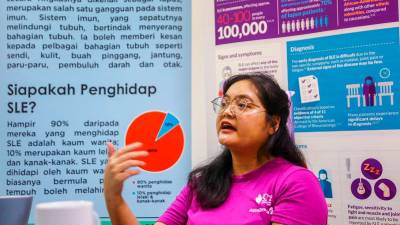PETALING JAYA: Systemic lupus erythematosus (SLE) quietly strikes thousands of Malaysians – mostly women – yet this crippling autoimmune disease is widely misunderstood, often ignored and dangerously misdiagnosed.
Malaysia SLE Association executive secretary Illani Azalia Zainal Abidin, 32, who is a lupus patient herself, knows the danger all too well. At 27, a sudden flare nearly killed her.
“It started with swelling of my face and hands. Three doctors said it was an allergy, while another suspected dengue,” she said.
“My body was changing and I did not understand what was happening. My hair was falling out. It was horrible.”
Only a private specialist finally gave the correct diagnosis – SLE or lupus, a chronic condition in which the immune system attacks the body’s own organs and tissues.
While the association has over 4,500 registered members, Illani said many more cases go undiagnosed, especially among men.
“About 90% of patients are women, usually aged between 15 and 50,” she said.
Her battle didn’t end with the diagnosis. Within a year, lupus had attacked her heart, lungs, and kidneys, causing lupus nephritis – a potentially life-threatening complication.
“Public hospitals collect samples in batches and results take days. Meanwhile, I am getting sicker,” she said.
Early treatment in the private sector saved her life, but drained her savings.
The biologic drug Rituximab brought temporary relief but cost between RM7,000 and RM8,000 per vial – four cycles plus hospital fees cost about RM40,000.
“I didn’t even have insurance then,” she said.
When Rituximab stopped working, doctors suggested chemotherapy. She refused, eventually switching to an oral transplant drug approved only after months of paperwork.
Today, her daily routine is strict: kidney medication morning and night, steroids at midday, each dose carefully timed with or without food.
The physical strain was only half the battle. High-dose steroids triggered depression.
“I wasn’t suicidal but I didn’t want to wake up,” she admitted. Intensive therapy – three sessions a week at first – helped her regain control.
Her family also felt the impact.
“They would tiptoe around me, afraid stress would trigger a flare. It can make a home feel dangerous,” she said.
Joining the association was transformative, she added.
“Before that, people pitied me. Here, nobody pities you – they just get it,” she said.
Monthly online sessions connect patients and caregivers nationwide, offering advice and support.
Access to care remains uneven, with rheumatologists available in Kuala Lumpur or Johor, while patients in Pahang or Sabah sometimes travel for hours – even by boat – just to see a doctor, she said.
Now experiencing remission, Illani still takes medication three times a day, attends monthly therapy and guards her energy.
“My friends schedule outings at night or indoors to accommodate my sensitivity to heat and light.”
Lupus has reshaped her personal dreams.
“The only challenge now is whether I can become pregnant,” she said, adding that adoption is her path forward.
Her message to fellow patients is blunt and clear:
“Learn about your body – its triggers, its limits and get support. Lupus follows you everywhere,” she said.
